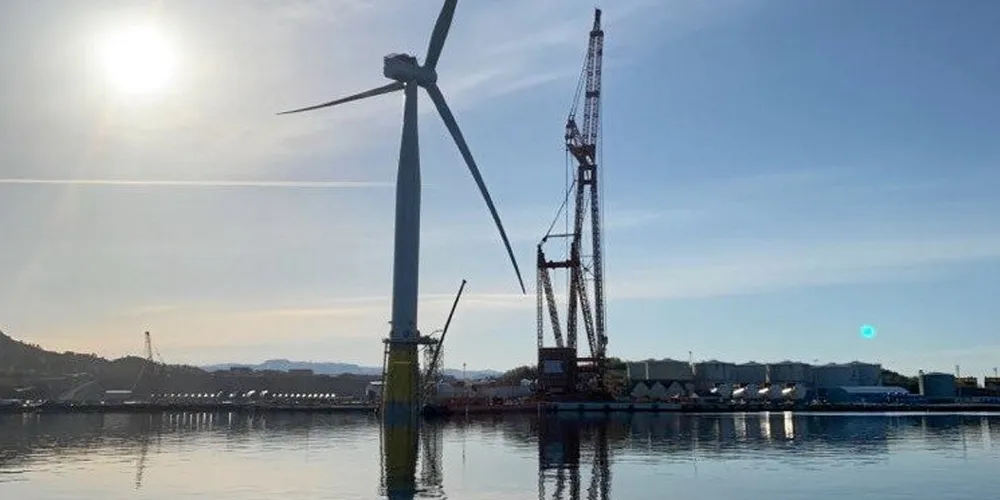'Shallow water' floating wind to broaden sector horizons as global boom looms
Lead-off tenders this year in Europe to spark 12GW build-out by 2030 with projects in sub-100m waters holding potential to accelerate expansion worldwide, says Aegir Insights

‘Shallow water’ floating wind projects are set to be key to spurring expansion of the sector toward its first gigawatts of installed plant, representing a “huge prize” for the companies that can commercially build lead-off arrays in waters of less than 100m, according to latest calculations from Aegir Insights.
The Copenhagen-based analyst, which expects the 106MW of floating turbines turning today to multiply to some 12GW by 2030, sees developments in water depths closer to those traditionally occupied by conventional foundations as being “massively neglected” to date by industry despite floating’s ever-lower levellised cost of energy (LCOE).
“While the technology for floating wind foundations is not yet commercialised, it will be soon, as the demand for electricity increases due to society’s electrification combined with phasing out of traditional energy sources. With high capacities per project, offshore wind is a very productive renewable energy source, and as costs have been falling steeply. Floating technology will take this high-capacity source to new markets.
“This current decade is all about ‘getting to gigawatts’ where we will learn about the scalability and come out with a pretty clear view of the long-term cost trajectory of floating.”
Urquhart noted it will “especially interesting to watch if floating will ‘step on the toes’ of the fixed-bottom industry to some extent” by mastering the challenges of shallow mooring.
“There is a dominant cluster of shallow floating projects, that is some 40% of the projects have under-100 metres water depth, which identifies the need for smart shallow mooring solutions,” said Urquhart.
“Every single meter gained in this precious transition range of 40-70 metres water depth opens up some huge substantially more capacity potential for floating, threatening the jacket and deep-water monopiles.”
Twelve of the 40 key developments spotlighted by Aegir, accounting for some 38GW, will be located in north-western Europe, where high winds, “proximity to supply chain, well known regulatory regimes and relatively shallow waters (60-200 metres)” will create a first wave of projects, producing power at a LCOE €50-60/MWh ($60-70/MWh).
Asia Pacific along with a number of new offshore wind markets in southern and eastern Europe are expected to come next, adopting the platform concepts that “win out” during the technology consolidation of the coming years, according to Aegir, while “a few, key US states with deep waters, ranging from 200-1,300 metres, will follow soon after”.
Africa, Middle East and South America are foreseen having “a handful of exciting project opportunities” in the longer-term.
“The floating offshore wind sector is at an inflexion point, with utility scale projects emerging in all corners of the world. The rapid cost out of offshore wind, plus floating technology’s location flexibility has brought an unprecedented rush to hunt the most competitive sites globally,” said Urquhart.
“This rush brings out plethora of new and old players –ranging from oil majors to land-grabbers and everything in between.
“European and Asian markets are driving the early buildout following on successful demonstration projects, but North America and Southern Europe could be fast followers.”
First tenders will serve to get the floating wind sector’s oars in the water, starting with auctions in France and Scotland in 2021, and Norway and the US Pacific in 2022, according to Aegir forecasts, which point to maiden commercial project deployments being ”just around the corner” in 2025-2030.
“Floating capacity build-out forecasts towards 2030 indicates a global build-out speed of 1-2GW per year,” said Urquhart.
Another determining factor will be the partnering between developers, technology providers – which will witness a “convergence” of platform types – and local partners in anticipation of coming bid rounds.
“There is an extremely complex network of actors in the floating sector – several developer partnerships differing by region and developers betting on one or more technologies in a highly competitive technology race,” said Urquhart, highlighting RWE, Equinor, Ocean Winds, Aker and Copenhagen Infrastructure Partners as examples of developers with “strengthening relationships” with technology outfits and regional players.
“We will also see a few floating concepts emerging securing the early volume / first mover advantage… Once a handful of floater OEMs get their first GWs under their belt it will be hard for late comers to catch them,” he said.
“Two floating concepts are substantially ahead of the pack – WindFloat and Hywind – in terms of demonstration, but the fundamental question is whether these two concepts can be industrialised to keep ahead of the second wave of concepts – Stiesdal, SBM, Saitec, OO-Star and BW Ideol. The latter, less mature floater concepts are already backed by large industry players, and new partnerships are announced regularly.”
Urquhart expects consolidation among the platform designs to emerge “in three to five years, as operational experience is gained through various demos and pre-commercial projects”.
An outrider to the floating wind sector’s development is the technology’s wider industrial applications beyond pure-play clean-power production, including offshore hydrogen generation and oil & gas emissions reduction plays, he noted.
“Higher capacity factors and locational flexibility ultimately leads to more opportunities to secure route-to-market, and different business models,” said Urquhart.
“Floating wind will open up several wind resource plays where developers can tap into 10-11.5 metre per second winds – which starts to feel more baseload-like compared to other competing renewables. This is will make floating ‘the most favoured electrons’ for hydrogen, and also for stressed grid operators trying to manage other variable renewables.
“And floating could be a lifeline to the oil & gas sector, making for a smoother transition of assets and skills to a new green future. Let’s still see how the economics of co-location play out, but I think today we have just about every major offshore E&P [oil exploration and production] player figuring out the economics of greening their portfolios.”
(Copyright)